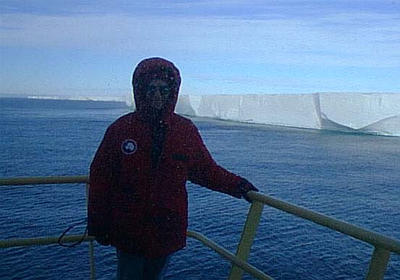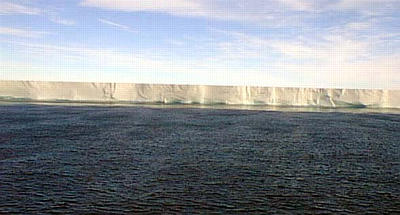13 February, 1999
February 13, 1999
Hello from Antarctica! Wow, what a day! We’ve finished our first 24 hours at
sea, and we all feel like we are starting to get into the swing of things. We
have started our first multibeam survey, which lasted most of today and will
continue into tomorrow. The multibeam is a type of sonar that is attached to
the bottom of the ship. It is used to help map the bottom of the Ross Sea.
Speaking of the Ross Sea, that is one of the geographic locations named after
Captain Ross (If you remember, yesterday’s question was "What geographic
location was named after Captain Ross?”). Actually, there are at least three
different locations named after Scotsman James Clark Ross. Ross was born in
1800 and joined the Royal Navy at the age of 11. Many of his earlier years at
sea were spent in the Arctic. Between 1818 and 1836, he spent eight winters
and 15 summers in the Arctic. In 1831, he was second-in-command on a voyage
with his uncle, John Ross, to locate the North Magnetic Pole. The "magnetic"
pole and the "geographic" pole are two different things. The Earth spins
around the geographic poles, which are found at 90 degrees North and South
latitude. The Earth's magnetic poles, however, are not found exactly at that
location. Compasses point to the North Magnetic Pole.
Ross also wanted to discover the location of the South Magnetic Pole, so his
set sail in 1839 with two strengthened ships ready to go through ice -- Erebus
and Terror. He spent the autumn in Hobart, Tasmania, and continued his trip
south in November of 1840. In early January, the ships pushed through pack
ice
for four days (his reinforced ships were the first that had been able to
withstand such conditions). On January 9, 1841, be broke through to open water
and became the first person to reach the Ross Ice Shelf (another geographic
location named after him). Today we saw the Ross Ice Shelf and it was really
neat! We began to see it from quite a long distance away. As the ship got
close to it I felt as though we were standing next to a huge wall of ice. I
stood on the metal walkway that surrounds the bridge in order to take my
pictures. I was five decks above the water level, and I still couldn’t see
the
top of the ice shelf! For tomorrow's question, what exactly is an ice shelf?
Captain Ross then continued south along a great chain of mountains, which is
called Victoria Land (he was still trying to find the South Magnetic Pole).
The advance came to a halt when Ross found a bay, which he named McMurdo Sound
after the first lieutenant on his ship, Archibald McMurdo. He discovered what
is now known as Ross Island (where McMurdo Station is located, and a third
geographic location named after Sir James Clark Ross), and named its two
mountains after his two ships -- Erebus and Terror. Ross continued trying to
reach the South Magnetic Pole, but he was eventually forced home in 1843 after
nearly four and a half years away. Ross married later that year, but only
after he signed an agreement with his bride's father that his days of polar
exploration would end. The South Magnetic Pole was first reached by Douglas
Mawson, David Edgeworth, and Alistair Mackay in 1909. It is currently located
at 65 degrees South Latitude and 139 degrees East Longitude, off the coast
near
Commonwealth Bay. Its position moves about 10 to 15 km per year in a north to
northwesterly direction.
Well, that’s enough for now. Don’t forget that you are more than welcome to
send me any questions that you may have. I’ll be back tomorrow!
Kim Giesting
Latitude: 77 degrees, 37 minutes South
Longitude: 177 degrees, 59 minutes East
Temperature: -12 degrees C (about 10 degrees F)

This is a picture of Kim and the ice shelf. She is standing on the walkway that surrounds the bridge.

This is a picture of the ship while it was still at McMurdo Station. The bridge is the large row of windows located near the top of the ship.

This is the Ross Ice Shelf.
Contact the TEA in the field at
.
If you cannot connect through your browser, copy the
TEA's e-mail address in the "To:" line of
your favorite e-mail package.
|
